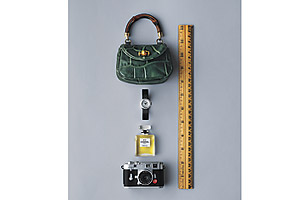
From top: Gucci Heritage Collection bag; La Mini D de Dior watch; Chanel no. 5 Parfum; Minox Leica M3 Classic digital camera
For all its cutting-edge brevity, Twitter has nothing on the creative geniuses of modern history. Hemingway once wrote a haunting story using a mere six words: "For Sale: Baby shoes. Never worn." Rodin sculpted a series of tiny hands no bigger than the top of his thumb. And Matisse set out with a 3-by-4-in. canvas, a bottle of ink and a mirror to produce a miniature self-portrait that would vanish into your pants pocket.
Christie's deputy chairman Jonathan Rendell took particular notice, however, when the minuscule Matisse went up for auction two years ago, and competitive bidding drove the price to about 10 times its estimate, more than a quarter-million dollars. That event was followed this past February by the sale of Yves Saint Laurent and partner Pierre Bergé's rarefied belongings, where, among other tiny treasures, a 6.5-in.-tall Belle Haleine perfume bottle by Marcel Duchamp was also driven to sell for nearly 10 times its estimate, this time $11.5 million. "There was definitely a feeling that people wanted an object that they could hold in their hand," says Rendell, who oversaw the sale, "rather than something that screamed from the wall."
The art world isn't alone in its penchant for diminutive things. As if designers were carrying the mandates of their boardrooms to the drawing table, the latest products coming from the design realm are quite literally downsized. There are handbags the size of hands, toylike automobiles — General Motors is banking on five tiny cars in its upcoming high-stakes lineup — and furniture companies are showing abridged versions of their most sought-after sofas and chairs. The wine industry is agog over microcuvées, tiny batches of custom-made wine. Professional foodies are all about microchic portions. And in place of their once leisurely sprawl, luxury hotel rooms and retail shops are popping up in dimensions formerly reserved for dressing rooms.
Small is certainly the buzzword among industry analysts. The luxury market showed zero growth in 2008 and is expected to shrink 10% in 2009, while consumer confidence in the U.S. has plummeted 60%, according to Bain & Co. Even so, in its May 2009 luxury-brands survey, Abrams Research concluded that "Luxury is here to stay," provided companies pare down to a "stronger, smaller core." What luxury consumers want now, says Bain, is to spend less without compromising on brand names or quality. And they want their luxe treats discreet. So the economy is all but demanding small gems, as designers — in league, knowingly or not — render them fashionable and thus supremely desirable.
Accessories — top moneymakers until recently and now suffering least in the luxury realm — have exploded on the runway in new, bite-size morsels that only up their irresistibility factor. At Proenza Schouler, the PS1 shoulder bag featured a second, extremely small one that zipped off it like charming handbag progeny. The VBH clutch that Michelle Obama carried on the town in New York City was a sliver of blue satin that looked like a jewel. And Karl Lagerfeld drove the point home at Chanel, where the models carried clear plastic handbags, each embedded with a menagerie of microaccessories: a tiny quilted Chanel purse, a tiny bottle of Chanel No. 5 perfume, even a tiny Chanel iPod, all packaged together as if to accompany a brand-new doll.
"I think there's a very high level of intimacy that people need from their products at the moment," says marketing guru and product designer Peter Arnell, whose pint-size electric car, the Peapod, debuted this year. "Americans have always asked, 'How big is big?' Big cars, big houses. Now we've gotten into our heads that things that are small are powerful and good. It's the power of the chip, the gigabyting of our lifestyle, which is really powerful."